Attached files
| file | filename |
|---|---|
| 8-K - 8-K - US BANCORP \DE\ | d507503d8k.htm |
| EX-99.1 - EX-99.1 - US BANCORP \DE\ | d507503dex991.htm |

U.S. Bancorp 2Q18 Earnings Conference Call July 18, 2018 Exhibit 99.2
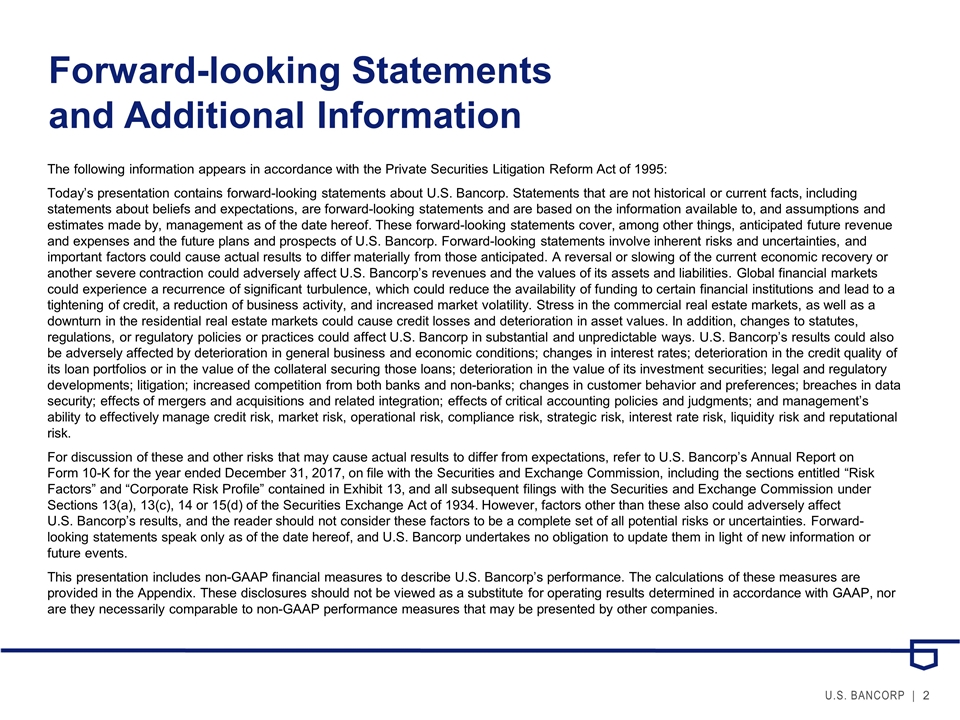
Forward-looking Statements and Additional Information The following information appears in accordance with the Private Securities Litigation Reform Act of 1995: Today’s presentation contains forward-looking statements about U.S. Bancorp. Statements that are not historical or current facts, including statements about beliefs and expectations, are forward-looking statements and are based on the information available to, and assumptions and estimates made by, management as of the date hereof. These forward-looking statements cover, among other things, anticipated future revenue and expenses and the future plans and prospects of U.S. Bancorp. Forward-looking statements involve inherent risks and uncertainties, and important factors could cause actual results to differ materially from those anticipated. A reversal or slowing of the current economic recovery or another severe contraction could adversely affect U.S. Bancorp’s revenues and the values of its assets and liabilities. Global financial markets could experience a recurrence of significant turbulence, which could reduce the availability of funding to certain financial institutions and lead to a tightening of credit, a reduction of business activity, and increased market volatility. Stress in the commercial real estate markets, as well as a downturn in the residential real estate markets could cause credit losses and deterioration in asset values. In addition, changes to statutes, regulations, or regulatory policies or practices could affect U.S. Bancorp in substantial and unpredictable ways. U.S. Bancorp’s results could also be adversely affected by deterioration in general business and economic conditions; changes in interest rates; deterioration in the credit quality of its loan portfolios or in the value of the collateral securing those loans; deterioration in the value of its investment securities; legal and regulatory developments; litigation; increased competition from both banks and non-banks; changes in customer behavior and preferences; breaches in data security; effects of mergers and acquisitions and related integration; effects of critical accounting policies and judgments; and management’s ability to effectively manage credit risk, market risk, operational risk, compliance risk, strategic risk, interest rate risk, liquidity risk and reputational risk. For discussion of these and other risks that may cause actual results to differ from expectations, refer to U.S. Bancorp’s Annual Report on Form 10-K for the year ended December 31, 2017, on file with the Securities and Exchange Commission, including the sections entitled “Risk Factors” and “Corporate Risk Profile” contained in Exhibit 13, and all subsequent filings with the Securities and Exchange Commission under Sections 13(a), 13(c), 14 or 15(d) of the Securities Exchange Act of 1934. However, factors other than these also could adversely affect U.S. Bancorp’s results, and the reader should not consider these factors to be a complete set of all potential risks or uncertainties. Forward-looking statements speak only as of the date hereof, and U.S. Bancorp undertakes no obligation to update them in light of new information or future events. This presentation includes non-GAAP financial measures to describe U.S. Bancorp’s performance. The calculations of these measures are provided in the Appendix. These disclosures should not be viewed as a substitute for operating results determined in accordance with GAAP, nor are they necessarily comparable to non-GAAP performance measures that may be presented by other companies.

2Q18 Highlights * Taxable-equivalent basis; see slide 26 for calculation ** Excluding the impact of the 2Q18 student loan portfolio sale, average total loans grew 0.3 percent linked quarter and 1.8 percent year-over-year **
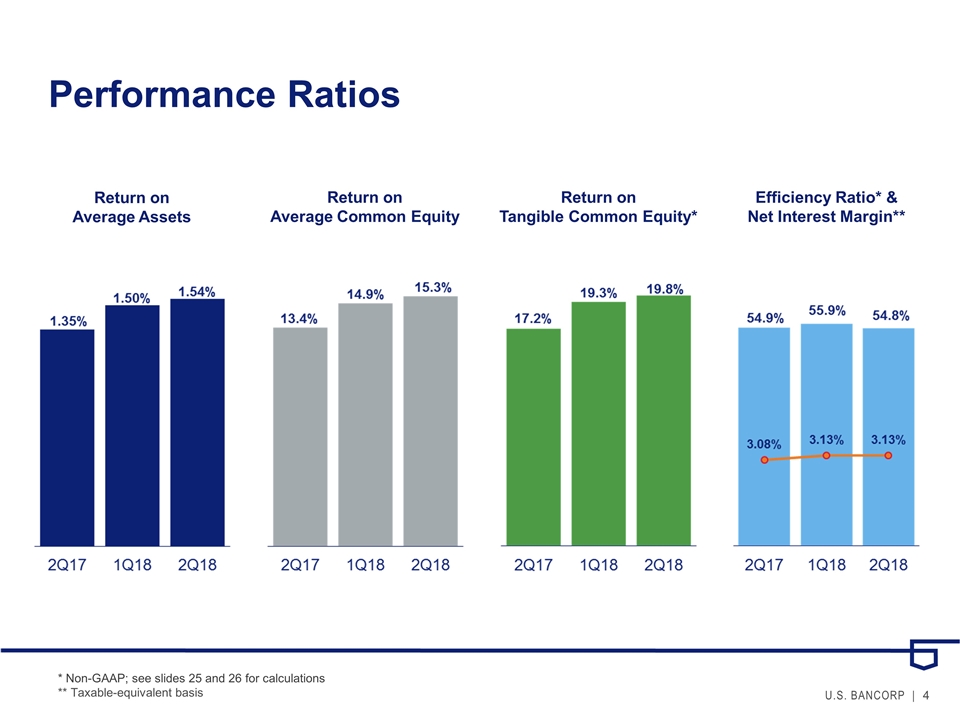
Performance Ratios Efficiency Ratio* & Net Interest Margin** * Non-GAAP; see slides 25 and 26 for calculations ** Taxable-equivalent basis Return on Average Common Equity Return on Tangible Common Equity* Return on Average Assets
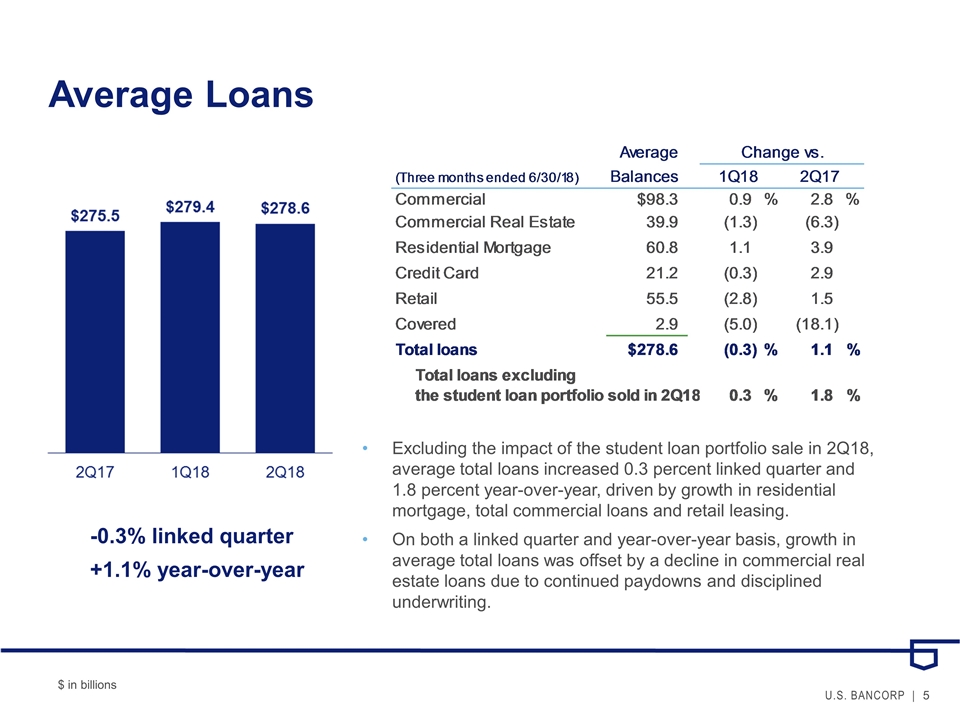
Average Loans -0.3% linked quarter +1.1% year-over-year Excluding the impact of the student loan portfolio sale in 2Q18, average total loans increased 0.3 percent linked quarter and 1.8 percent year-over-year, driven by growth in residential mortgage, total commercial loans and retail leasing. On both a linked quarter and year-over-year basis, growth in average total loans was offset by a decline in commercial real estate loans due to continued paydowns and disciplined underwriting. $ in billions
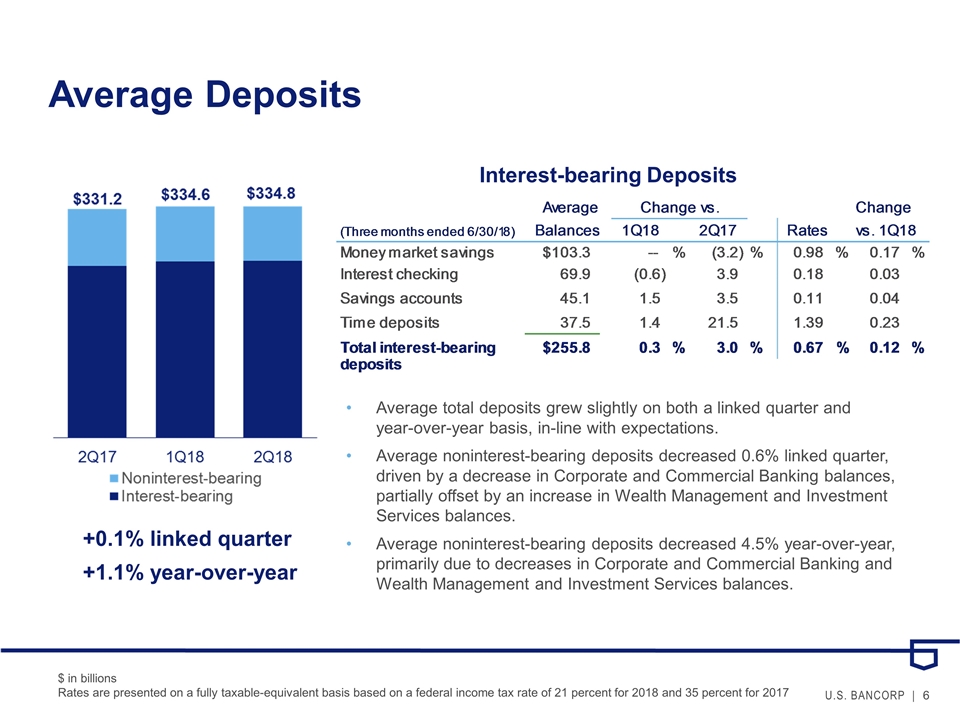
Average Deposits +0.1% linked quarter +1.1% year-over-year $ in billions Rates are presented on a fully taxable-equivalent basis based on a federal income tax rate of 21 percent for 2018 and 35 percent for 2017 Interest-bearing Deposits Average total deposits grew slightly on both a linked quarter and year-over-year basis, in-line with expectations. Average noninterest-bearing deposits decreased 0.6% linked quarter, driven by a decrease in Corporate and Commercial Banking balances, partially offset by an increase in Wealth Management and Investment Services balances. Average noninterest-bearing deposits decreased 4.5% year-over-year, primarily due to decreases in Corporate and Commercial Banking and Wealth Management and Investment Services balances.
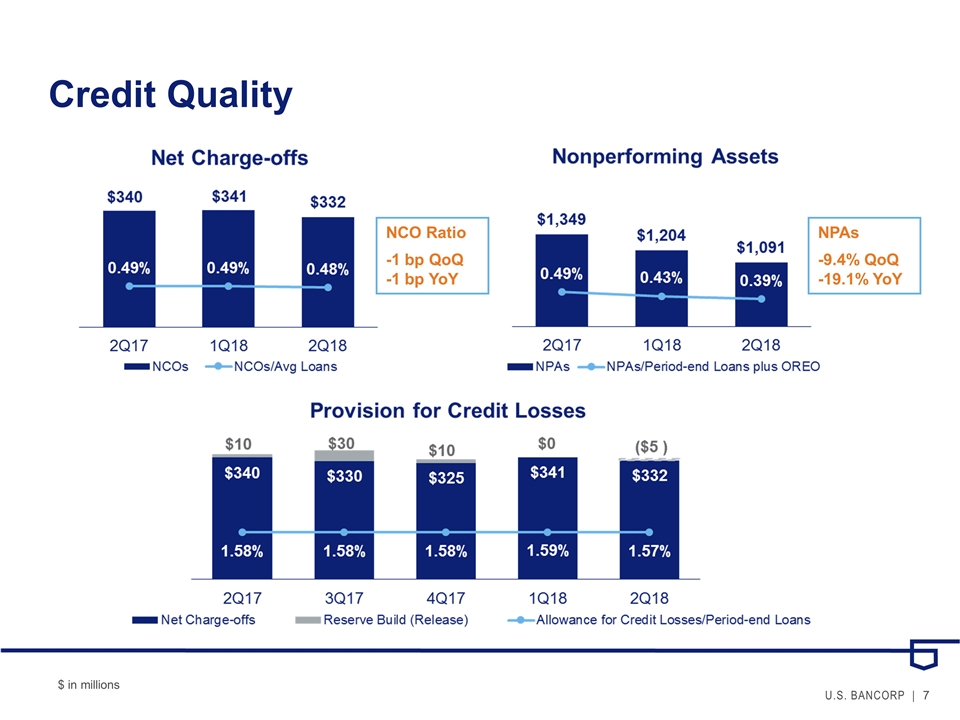
Credit Quality $ in millions NCO Ratio -1 bp QoQ -1 bp YoY NPAs -9.4% QoQ -19.1% YoY

Earnings Summary

Net Interest Income Linked Quarter Growth in net interest income was primarily driven by the impact of higher interest rates and an additional day in the second quarter. The net interest margin was flat, reflecting the impact of higher interest rates offset by a deposit and funding mix shift. Year-over-Year Net interest income growth was principally driven by growth in earning assets and the impact of rising interest rates. The net interest margin increased five basis points as the impact of higher interest rates was offset by loan mix, higher funding costs and the impact of tax reform of two basis points. $ in millions Taxable-equivalent basis +0.9% linked quarter +4.1% year-over-year
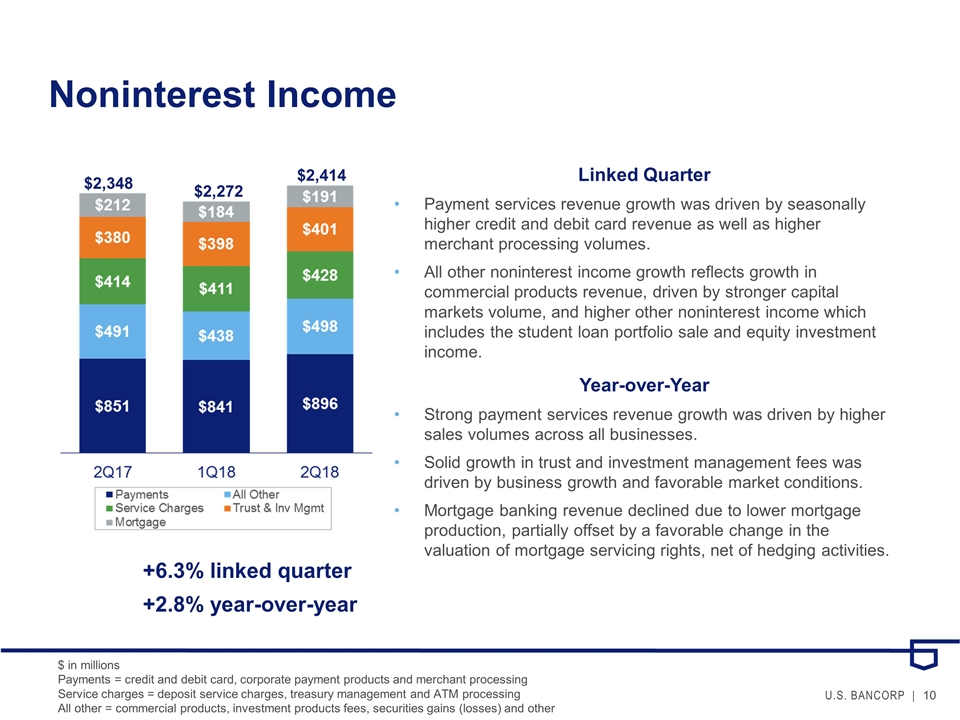
Noninterest Income $ in millions Payments = credit and debit card, corporate payment products and merchant processing Service charges = deposit service charges, treasury management and ATM processing All other = commercial products, investment products fees, securities gains (losses) and other $2,348 $2,272 $2,414 Linked Quarter Payment services revenue growth was driven by seasonally higher credit and debit card revenue as well as higher merchant processing volumes. All other noninterest income growth reflects growth in commercial products revenue, driven by stronger capital markets volume, and higher other noninterest income which includes the student loan portfolio sale and equity investment income. Year-over-Year Strong payment services revenue growth was driven by higher sales volumes across all businesses. Solid growth in trust and investment management fees was driven by business growth and favorable market conditions. Mortgage banking revenue declined due to lower mortgage production, partially offset by a favorable change in the valuation of mortgage servicing rights, net of hedging activities. +6.3% linked quarter +2.8% year-over-year

Noninterest Expense Linked Quarter Noninterest expense growth was primarily driven by seasonally higher professional services and marketing and business development expense as well as higher compensation expense. Employee benefits expense saw a seasonal decline due to higher payroll taxes during the first quarter of each year. Year-over-Year Noninterest expense growth was driven by higher personnel costs and technology investment. Growth in compensation and employee benefits expense reflects the impact of hiring to support business growth and compliance programs, merit increases, higher variable compensation related to business production and increased medical costs. $ in millions +1.0% linked quarter +3.4% year-over-year $2,984 $3,055 $3,085
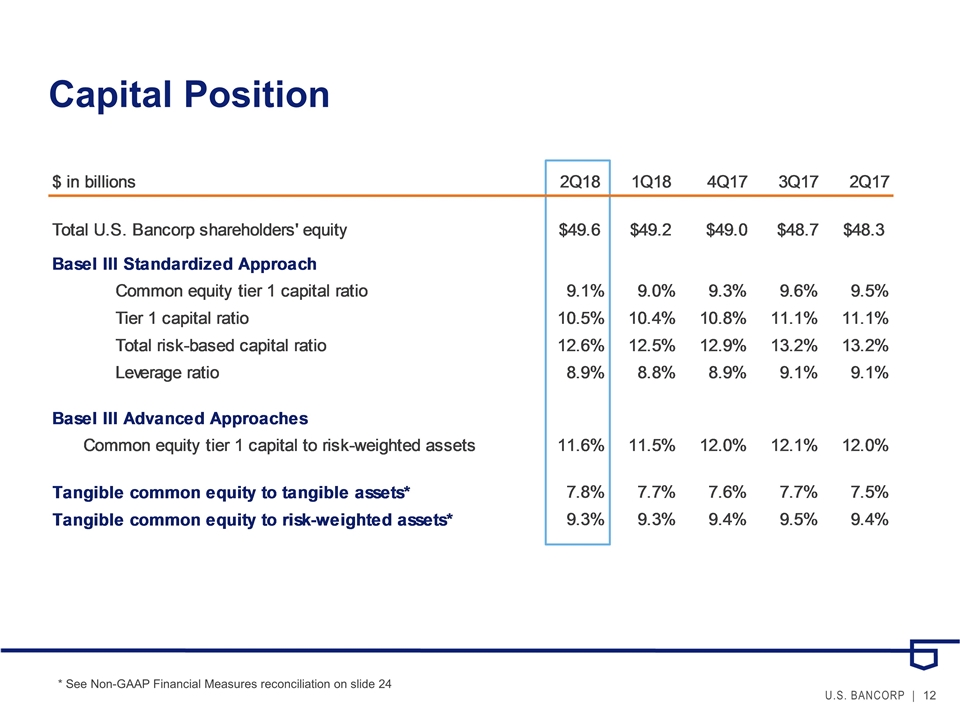
Capital Position * See Non-GAAP Financial Measures reconciliation on slide 24
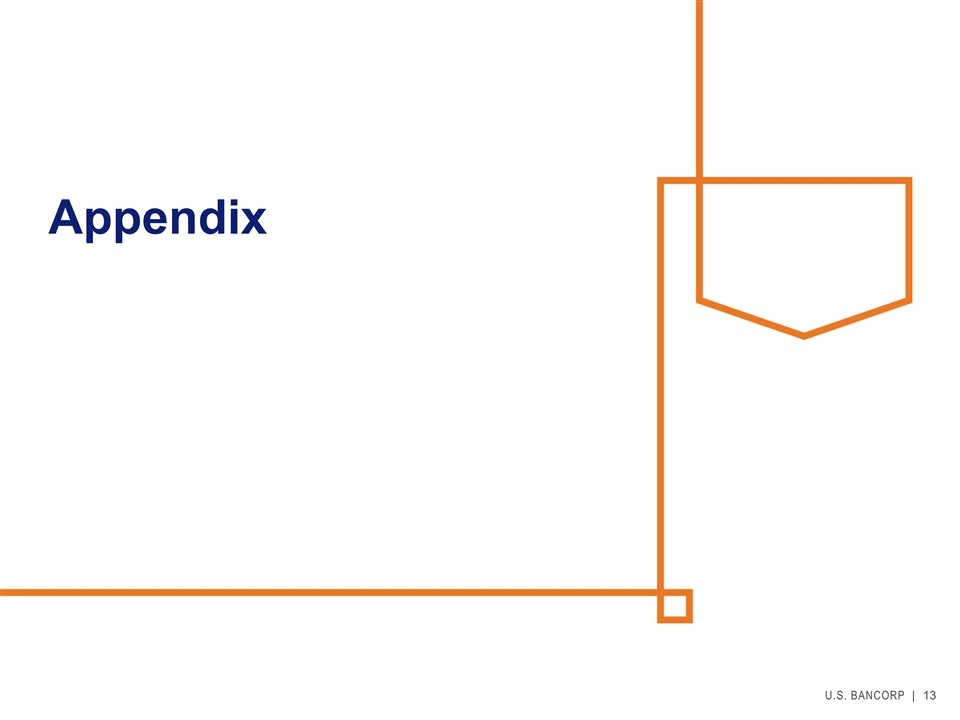
Appendix
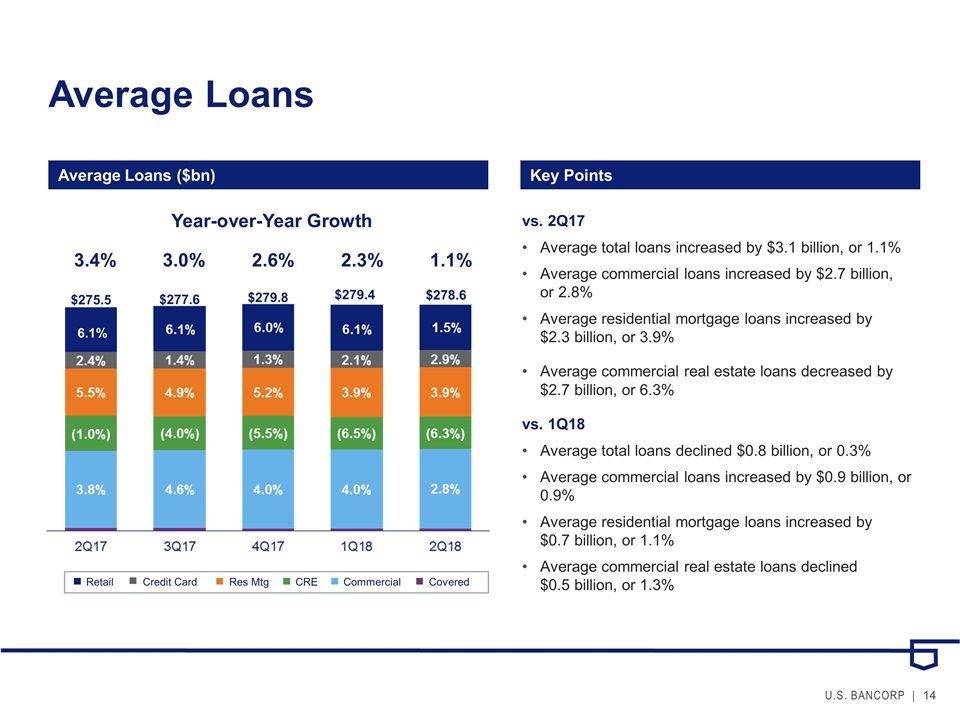
Average Loans vs. 2Q17 Average total loans increased by $3.1 billion, or 1.1% Average commercial loans increased by $2.7 billion, or 2.8% Average residential mortgage loans increased by $2.3 billion, or 3.9% Average commercial real estate loans decreased by $2.7 billion, or 6.3% vs. 1Q18 Average total loans declined $0.8 billion, or 0.3% Average commercial loans increased by $0.9 billion, or 0.9% Average residential mortgage loans increased by $0.7 billion, or 1.1% Average commercial real estate loans declined $0.5 billion, or 1.3% Key Points Year-over-Year Growth 3.4% 3.0% 2.6% 2.3% 1.1% Covered Commercial CRE Res Mtg Retail Credit Card $279.8 $275.5 $277.6 6.1% $278.6 Average Loans ($bn) $279.4
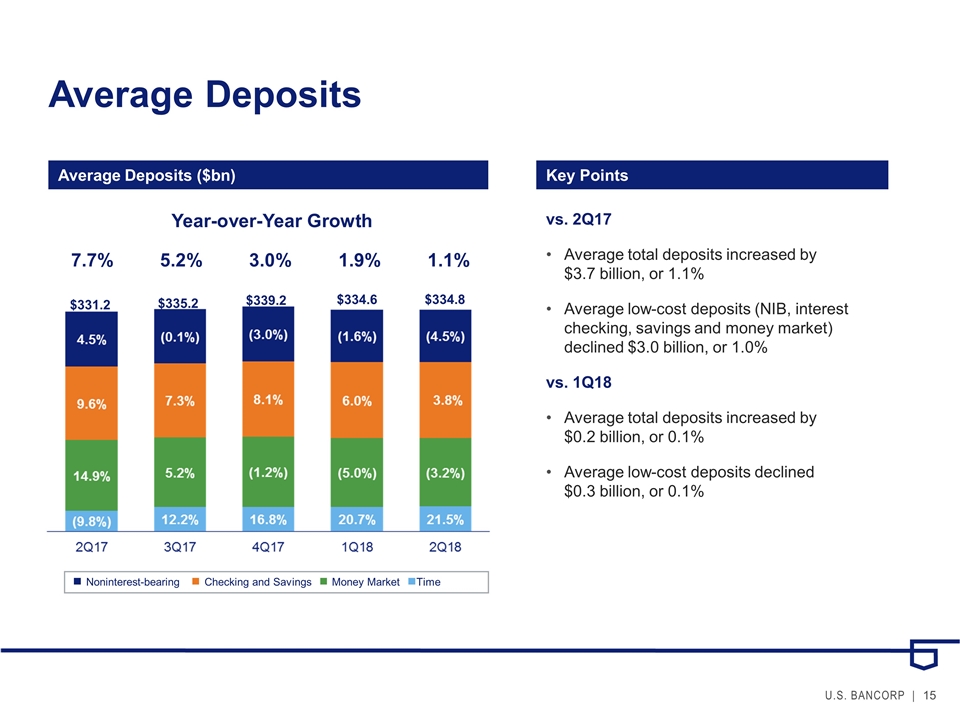
Average Deposits Key Points Average Deposits ($bn) vs. 2Q17 Average total deposits increased by $3.7 billion, or 1.1% Average low-cost deposits (NIB, interest checking, savings and money market) declined $3.0 billion, or 1.0% vs. 1Q18 Average total deposits increased by $0.2 billion, or 0.1% Average low-cost deposits declined $0.3 billion, or 0.1% Year-over-Year Growth 7.7% 5.2% 3.0% 1.9% 1.1% Time Money Market Checking and Savings Noninterest-bearing $334.8 $331.2 $335.2 $339.2 $334.6

Credit Quality – Commercial Loans Average Loans ($mm) and Net Charge-offs Ratio Key Statistics Key Points $mm2Q171Q182Q18 Average Loans$95,638$97,465$98,353 30-89 Delinquencies0.27%0.25%0.23% 90+ Delinquencies0.05%0.06%0.06% Nonperforming Loans0.33%0.31%0.23% Linked Quarter Growth 2.0% 1.0% 1.0% (0.1%) 0.9% Linked quarter growth of 0.9% was primarily driven by increased capital expenditure investment in the middle market segment Net charge-offs were stable quarter-over-quarter and lower year-over-year due to lower gross charge-offs
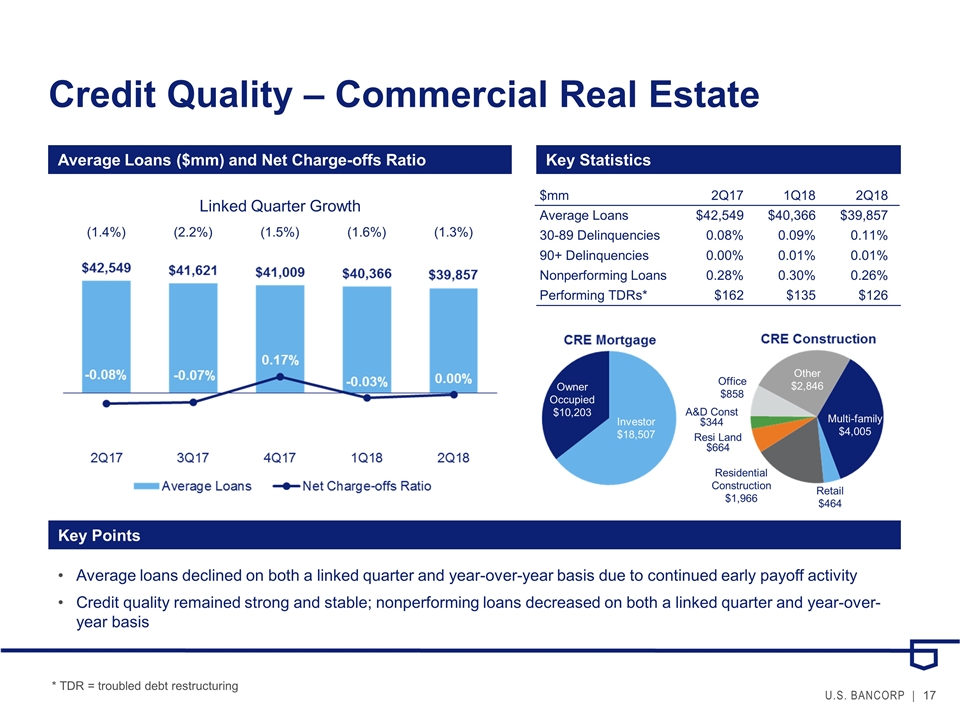
Investor $18,507 Owner Occupied $10,203 A&D Const $344 Multi-family $4,005 Retail $464 Residential Construction $1,966 Office $858 Other $2,846 Resi Land $664 $mm2Q171Q182Q18 Average Loans$42,549$40,366$39,857 30-89 Delinquencies0.08%0.09%0.11% 90+ Delinquencies0.00%0.01%0.01% Nonperforming Loans0.28%0.30%0.26% Performing TDRs*$162$135$126 Credit Quality – Commercial Real Estate Average Loans ($mm) and Net Charge-offs Ratio Key Statistics Key Points * TDR = troubled debt restructuring Linked Quarter Growth (1.4%) (2.2%) (1.5%) (1.6%) (1.3%) Average loans declined on both a linked quarter and year-over-year basis due to continued early payoff activity Credit quality remained strong and stable; nonperforming loans decreased on both a linked quarter and year-over-year basis
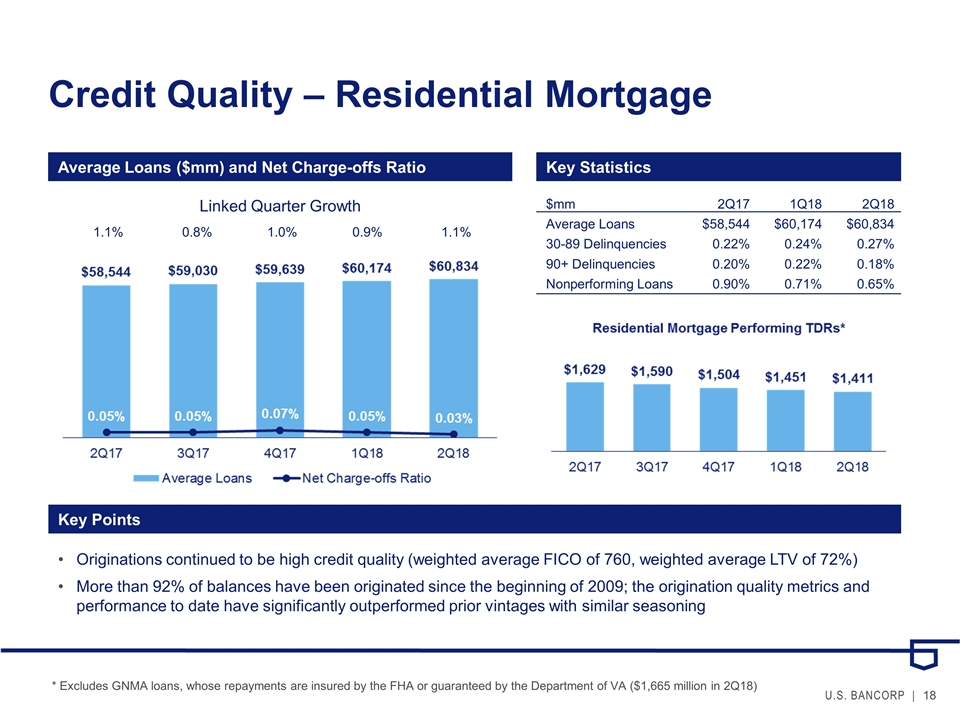
Credit Quality – Residential Mortgage Average Loans ($mm) and Net Charge-offs Ratio Key Statistics Key Points $mm2Q171Q182Q18 Average Loans$58,544$60,174$60,834 30-89 Delinquencies0.22%0.24%0.27% 90+ Delinquencies0.20%0.22%0.18% Nonperforming Loans0.90%0.71%0.65% * Excludes GNMA loans, whose repayments are insured by the FHA or guaranteed by the Department of VA ($1,665 million in 2Q18) Linked Quarter Growth 1.1% 0.8% 1.0% 0.9% 1.1% Originations continued to be high credit quality (weighted average FICO of 760, weighted average LTV of 72%) More than 92% of balances have been originated since the beginning of 2009; the origination quality metrics and performance to date have significantly outperformed prior vintages with similar seasoning
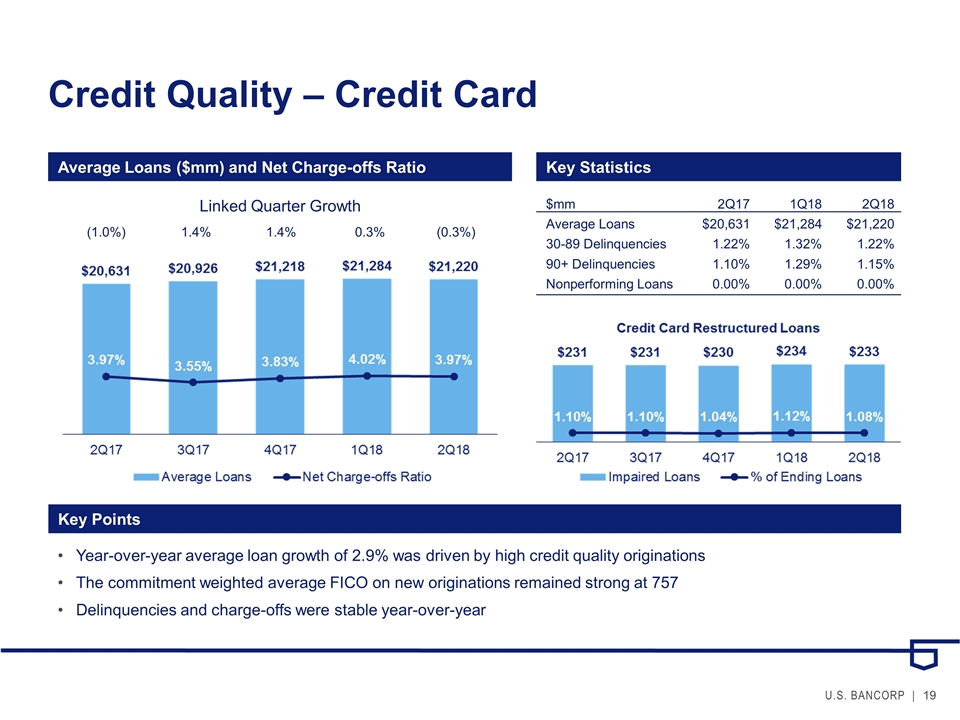
Credit Quality – Credit Card Average Loans ($mm) and Net Charge-offs Ratio Key Statistics Key Points $mm2Q171Q182Q18 Average Loans$20,631$21,284$21,220 30-89 Delinquencies1.22%1.32%1.22% 90+ Delinquencies1.10%1.29%1.15% Nonperforming Loans0.00%0.00%0.00% Linked Quarter Growth (1.0%) 1.4% 1.4% 0.3% (0.3%) Year-over-year average loan growth of 2.9% was driven by high credit quality originations The commitment weighted average FICO on new originations remained strong at 757 Delinquencies and charge-offs were stable year-over-year
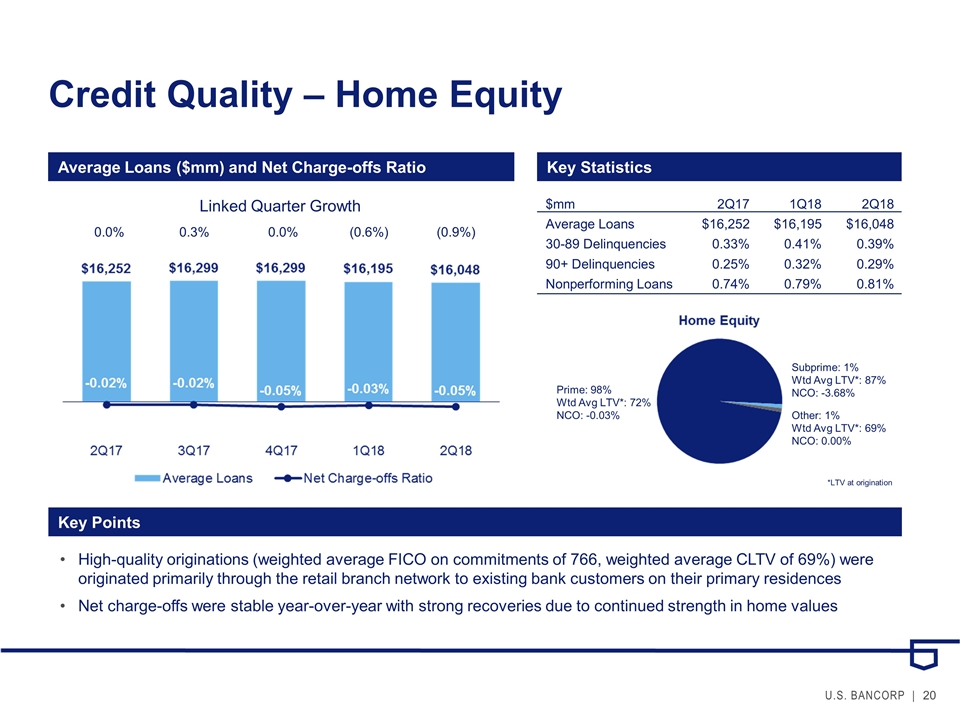
Credit Quality – Home Equity Average Loans ($mm) and Net Charge-offs Ratio Key Points Key Statistics $mm2Q171Q182Q18 Average Loans$16,252$16,195$16,048 30-89 Delinquencies0.33%0.41%0.39% 90+ Delinquencies0.25%0.32%0.29% Nonperforming Loans0.74%0.79%0.81% Subprime: 1% Wtd Avg LTV*: 87% NCO: -3.68% Prime: 98% Wtd Avg LTV*: 72% NCO: -0.03% Other: 1% Wtd Avg LTV*: 69% NCO: 0.00% *LTV at origination Linked Quarter Growth 0.0% 0.3% 0.0% (0.6%) (0.9%) High-quality originations (weighted average FICO on commitments of 766, weighted average CLTV of 69%) were originated primarily through the retail branch network to existing bank customers on their primary residences Net charge-offs were stable year-over-year with strong recoveries due to continued strength in home values
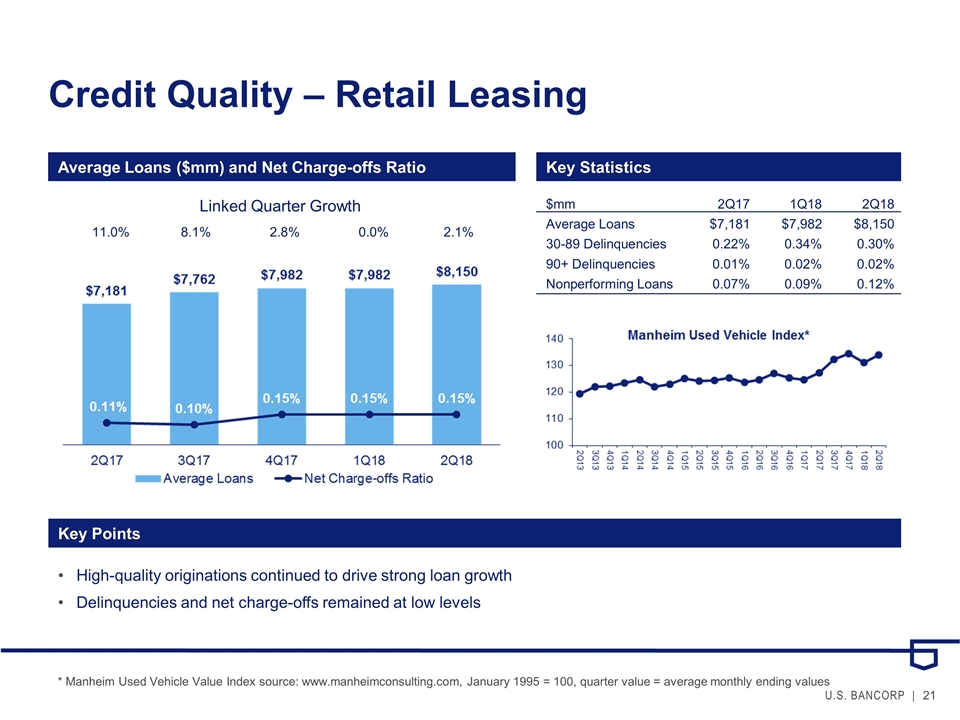
Credit Quality – Retail Leasing Average Loans ($mm) and Net Charge-offs Ratio Key Statistics Key Points $mm2Q171Q182Q18 Average Loans$7,181$7,982$8,150 30-89 Delinquencies0.22%0.34%0.30% 90+ Delinquencies0.01%0.02%0.02% Nonperforming Loans0.07%0.09%0.12% * Manheim Used Vehicle Value Index source: www.manheimconsulting.com, January 1995 = 100, quarter value = average monthly ending values Linked Quarter Growth 11.0% 8.1% 2.8% 0.0% 2.1% High-quality originations continued to drive strong loan growth Delinquencies and net charge-offs remained at low levels

Credit Quality – Other Retail Average Loans ($mm) and Net Charge-offs Ratio Key Statistics Key Points $mm2Q171Q182Q18 Average Loans$31,194$32,874$31,265 30-89 Delinquencies0.65%0.73%0.75% 90+ Delinquencies0.11%0.15%0.13% Nonperforming Loans0.10%0.11%0.12% Linked Quarter Growth 0.4% 2.6% 2.6% 0.1% (4.9%) The linked quarter decline in average loans was primarily driven by the student loan portfolio sale Net charge-offs, delinquencies and nonperforming loans were all relatively stable and consistent with the low levels experienced in recent quarters
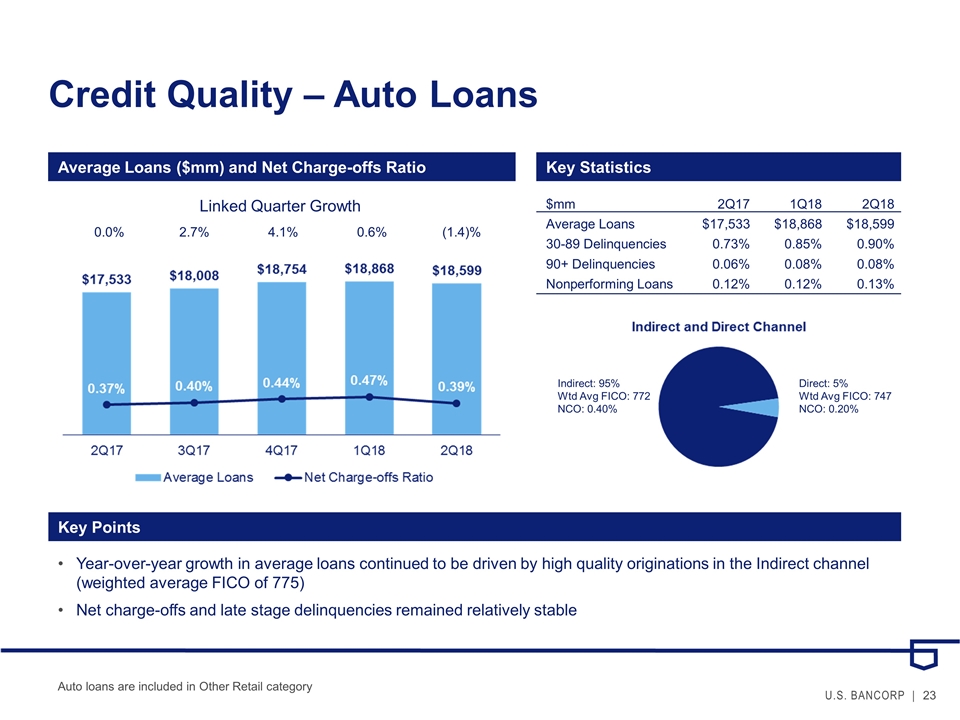
Credit Quality – Auto Loans Average Loans ($mm) and Net Charge-offs Ratio Key Statistics Key Points $mm2Q171Q182Q18 Average Loans$17,533$18,868$18,599 30-89 Delinquencies0.73%0.85%0.90% 90+ Delinquencies0.06%0.08%0.08% Nonperforming Loans0.12%0.12%0.13% Direct: 5% Wtd Avg FICO: 747 NCO: 0.20% Indirect: 95% Wtd Avg FICO: 772 NCO: 0.40% Auto loans are included in Other Retail category Linked Quarter Growth 0.0% 2.7% 4.1% 0.6% (1.4)% Year-over-year growth in average loans continued to be driven by high quality originations in the Indirect channel (weighted average FICO of 775) Net charge-offs and late stage delinquencies remained relatively stable
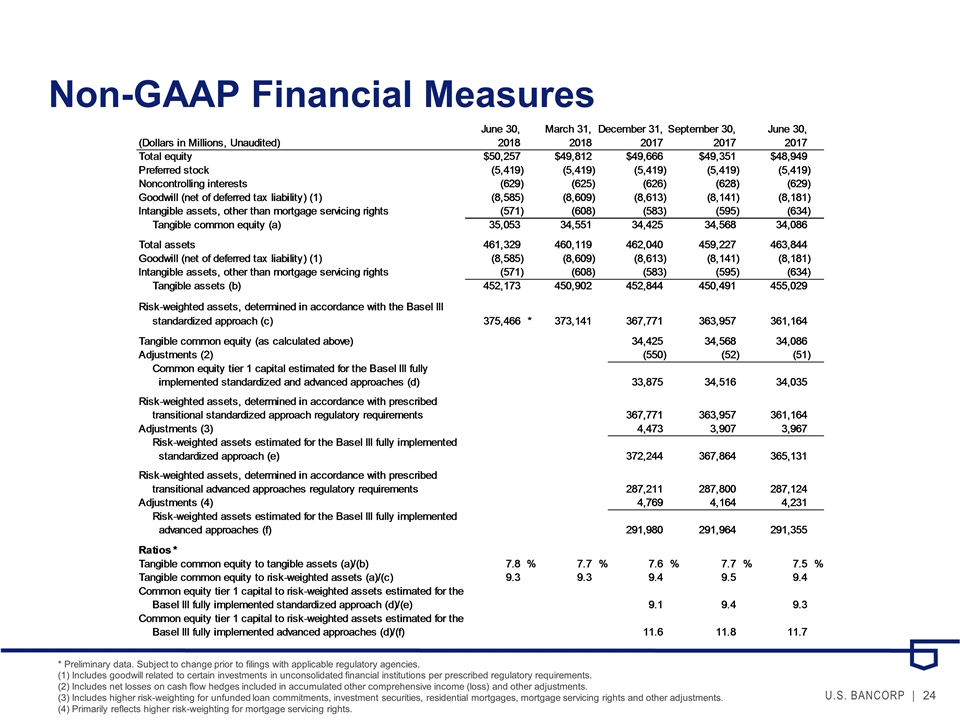
Non-GAAP Financial Measures * Preliminary data. Subject to change prior to filings with applicable regulatory agencies. (1) Includes goodwill related to certain investments in unconsolidated financial institutions per prescribed regulatory requirements. (2) Includes net losses on cash flow hedges included in accumulated other comprehensive income (loss) and other adjustments. (3) Includes higher risk-weighting for unfunded loan commitments, investment securities, residential mortgages, mortgage servicing rights and other adjustments. (4) Primarily reflects higher risk-weighting for mortgage servicing rights.

Non-GAAP Financial Measures (1) Includes goodwill related to certain investments in unconsolidated financial institutions per prescribed regulatory requirements.
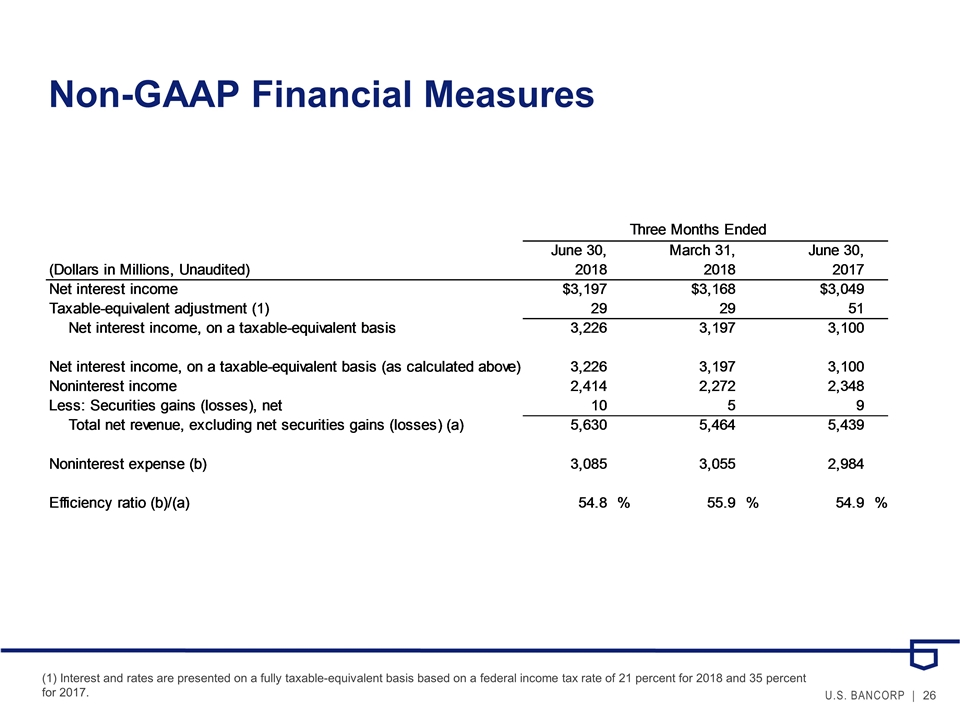
Non-GAAP Financial Measures (1) Interest and rates are presented on a fully taxable-equivalent basis based on a federal income tax rate of 21 percent for 2018 and 35 percent for 2017.
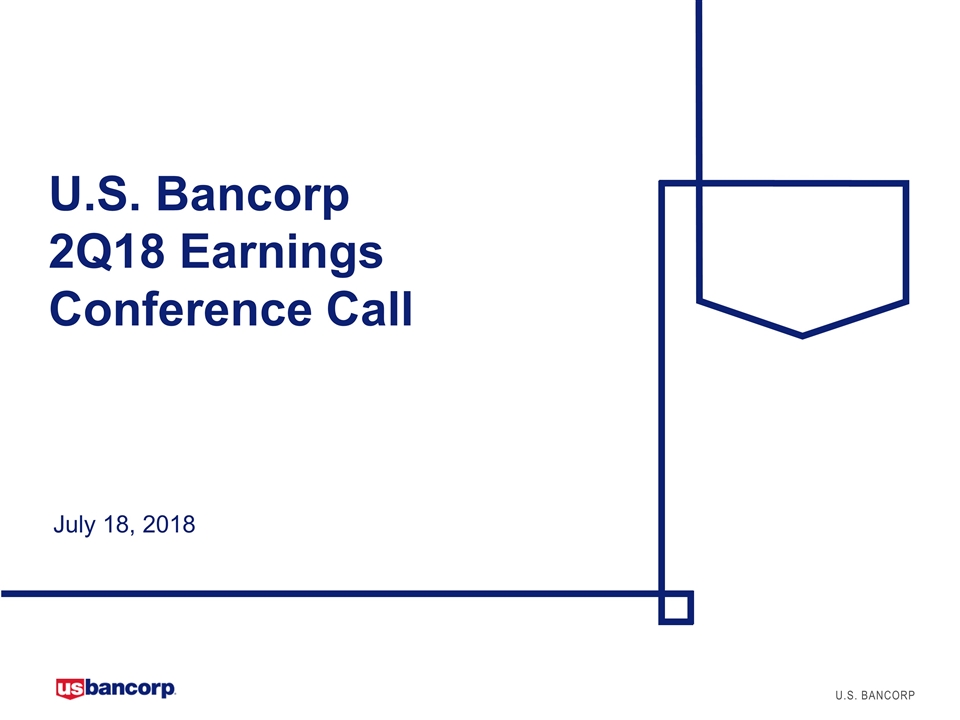
U.S. Bancorp 2Q18 Earnings Conference Call July 18, 2018
